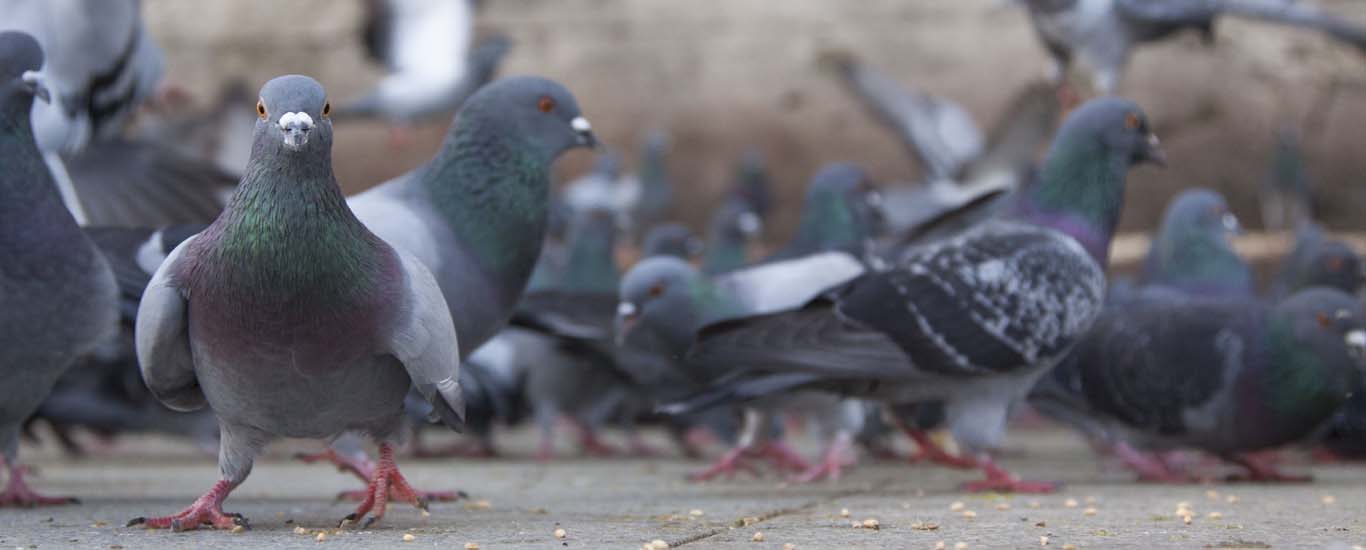
Pigeons are commonly kept around the world. Scientific name of domestic pigeon is Columba livia domesticus. It has been considered that pigeon is the first bird to be domesticated round about 6500 years ago. Pigeons can flight 15-30 miles per hour. Pigeons were used to carry the message from one place to another, racing and as a household pets. Pigeon flocks have equal number of male and females. They make pair for whole life like humans but if one die, one can find another. Domestic pigeon has respiratory rate of 25-30 per minute, Heart rate 240 bpm and 101.84- 104 Fahrenheit body temperature. Pigeon can live up to 30 years. There are at least 800 breeds of domesticated pigeons.
The hobby of pigeon keeping and breeding
Such hobby is prevalent throughout the world. Pigeons are reared for recreation, entertainment and aesthetic satisfaction. The hobby of keeping and breeding pigeons by pigeon fanciers, for flying, racing, homing and show is popular occupation throughout the world. Belgium is the capital of pigeon fancier’s.
The world’s most valuable racing pigeon, named Bolt (named after Usain Bolt, world’s fastest runner) was sold in 2013 for $410,000 by a Belgian pigeon fancier, Leo Heremans, to a Chinese businessman , and in 2017 it was Belgian’s ‘Golden Prince’ sold for $465,000 at an auction conducted by PIPA, which organizes the largest meeting event for pigeon fanciers. Nicolaas Gijselbrecht, a Belgian national, runs the world’s biggest pigeon website, “Pigeon Paradise@PIPA_be”, which has more than a million followers worldwide.
Female lays eggs at the age of 5-6 months. Female can breed up to eight times a year for up to five years. Egg hatches in about 18-19 days. After hatching, both male and female take care the young untill young becomes two year old. It has been reported that pigeon have higher intelligence than the 3-years old child. Pigeon can recognize all English alphabets. Pigeons have great memory, For example pigeon can return home if he released 400-600 miles away. Speed of racing pigeon can be 60mph.
Pigeons and infectious diseases
Pigeons are de-wormed according to their types. Some pigeon diseases are described below:
- Young pigeon disease (YPD) syndrome
Causative agent of this disease is still unknown. This disease occurs mostly in young racing and ornamental pigeon about the age of 2-6 months. There are different hypothesis about this disease for example this disease is associated with contact of infectious birds of different lofts and stress. In flock this disease often occurs after 3-7 days due to flight or exhibition. In flock it can cause 20% mortality and 20-80% morbidity. If this disease occurs in individual pigeon, then recovery can be done in three to five days. In individual pigeon it rarely cause peracute death. In individual chronic disease can be caused due to complication factor such as massive infection due to Trichomonas gallinae.
- Clinical signs:
- Reduced general body condition
- First sign pigeon ignore feeding signal
- Crop filled with feed and water
- Inappetence
- Weight loss
- Slimy diarrhea
- Regurgitation
- Treatment: Antibiotics, recovery depends upon duration and severity of disease, efficiency of treatment.
- Prevention: provide clean water. To reduce stress, many training flights and disinfection of the loft and all facilities
- Ectoparasites problems
Different types of lices, mites and fleas create problems in pigeon .These parasites cause skin irritation, feather damage, restlessness and blood loss. Treatments with pyrethrin sprays and ivermectin are effective.
- Pigeon pox
It is caused by pigeon poxvirus. This virus is stable in environment and can survive for many years in dried organic debris. The virus of this disease enter through abraded skin. This virus enter into the body directly through fighting, preening and feather picking. Indirectly this virus is enter through mosquitoes bite. This virus takes 7-9 days to cause disease. This disease is self-limiting but sometimes lesion become infected and painful interfere with respiration, eating and vision. If we remove scabs forcefully, it will cause deformity and scarring.
- Clinical signs:
Pigeon pox has 2 different forms.
- Wet form: In this fibronecrotic diphtheritic lesions are formed in oropharynx area. This form is less commonly seen.
- Dry form: In this form unfeathered parts of the body especially the beak and eyelids contains discrete scabby lesions.
Vaccination can be done for this disease. An attenuated live vaccine is available. Vaccination should be done to birds older than 6 weeks .Vaccination must be given at least six weeks prior to the onset of racing season because vaccinated birds remain infectious for 4-6 weeks to other birds. Bird which show sign of this disease should not vaccinated. Mosquito should be controlled.
- Trichomoniasis: (Canker)
Causative agent of this disease is ‘Trichomonas gallinae’. It is a motile protozoan parasite. It is among the parasites which are commonly seen in pigeons. It enters through faeces, crop secretion and saliva. It has two fotms, lentogenic and velogenic. These forms cause necrotic ulceration of mouth, esophagus, crop and proventriculus. That’s why swabbing crop is best diagnostic method for this disease.
- Clinical signs: High mortality rate, dysentery, regurgitation and high-rolling.
- Treatment: For the treatment of this disease nitroimidazoles (Dimetridazole and Metronidazole) can be used .These drugs have good effects on it.
- Coccidiosis
It is highly infectious and common disease which is caused by Emeria spp For example Eimeria labbeana and E. columbarum. It mostly affects intestine of the birds. It can be found in all pigeons but adults are usually resistance to it and Young are highly susceptible to it, which takes more stress. Adult bird can be infected through drinking unclean water and moist droppings.
- Clinical signs: Bird not show desire to eat or drink. Bird not show movement and often close their eyes. Watery greenish diarrhea is often seen. Bird remain puffed up on perches. Death can occur in young.
- Treatment: sulfadimethoxine is highly effective against it.
- Prevention:
- Keep loft dry and clean
- Use proper Antifungal
- Prevent the food contamination from droppings
- Regularly disinfect water
- Keep feed and water from contact with rodents
- Always isolate new bird
5.ONE EYED COLD SYNDROME:
It is common and non-specific clinical entity in pigeon. It is also called eye cold, opthalmia and big eye. It is multifactorial disease. Some times it may occurs due to vitamin A deficiency. In this disease lesions do not spread. In this syndrome one eye can completely closed if infection is at peak.
- Clinical signs: Watery ocular discharge, swollen eyelid with conjunctivitis, lethargy, lack of appetite.
- Treatment: Oxytetracycline and eye ointment can be used. Affected bird should be screened for trichomoniasis.
- Hypocalcaemia
It occurs in breeding hens (Female pigeon) due to lack of nutrition in feed. Paresis of feet and wings, especially when first egg is laid, it is the most common syndrome. Bird affected with this syndrome is unable to fly and it is often seen that bird drag herself by using beak and her wings for support. Supportive care, Vitamin D3 and calcium supply is highly effective in this case.
- Paratyphoid – Salmonellosis
This disease is caused by gram-negative bacteria (Salmonella typhimurium var. copenhageni, S. arizonae). Flagellum helps in the movement of this bacteria. Rodents, roaches, soles of fancier shoes and infected pigeon can transmit this bacteria to other pigeons. Adult birds are carrier for this disease.
- Clinical signs:
In salmonellosis, different types of signs and symptoms can appear due to movement of its causative agent. Most of the adults show decrease in weight, greenish diarrhea, red-swollen and painful joints in legs and wings can also be seen. Infertility can also be seen in flock. Baby birds can die before the second week after hatching. Baby birds can also show the signs of laboured breathing. Dying of young one in egg is another symptom of this disease.
- Treatment: Antibiotics treatment is based on sensitivity test but Enrofloxacin is commonly used. Treatment requires 3-8 days.
- Prevention: Regular cleaning and disinfecting the lofts, drinkers and feeders is important. Minimize the contact with rodents, wild birds and roaches. Vaccination should be done. Maintain acid pH below 4. Nolvasan disinfectant together with improver at one teaspoon per 4.5 litters of drinking water regularly will help to maintain acid environment in droppings.
- Nutritional deficiency: It is a common problem in pigeon rearing. Vitamin B1 and B2 deficiency is mostly seen. Birds having nutritional deficiency show neck paralysis, birds can not eat and drink as a result they die. Feed full of nutrient should be recommended.
Monitoring Procedures in pigeon rearing:
Particular attention must be paid to:
- Ectoparasites and endoparasite that may be present in feces
- Signs of salmonella spp
- General body condition
- Molting or feather disturbances
If disease is suspected in bird, then take a swab from cloaca or crop for cytology, Gram’s stains and culture it. Necropsy of poor performer or disease suspected bird is necessary to monitor the disease status in the flock.
Vaccinations:
Routine vaccination is important. Vaccination in pigeon may vary among countries.
After three weeks of age, Paramyxovirus vaccine should be given and thereafter once a year about three weeks before breeding. After five weeks of age, pox vaccine should be given and thereafter once a year about three weeks before exhibition/racing season. After five weeks of age, Salmonella vaccine should also be given and thereafter twice at two weeks interval and three weeks before breeding.
-By Inam Ullah Yasir, Muhammad Ilyas, Kamran Sajid, Muhammad Saqib, University of Veterinary and Animal Sciences, Lahore, Jhang Campus







